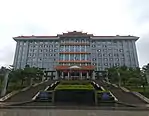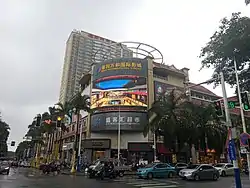Ruili
Ruili (simplified Chinese: 瑞丽; traditional Chinese: 瑞麗; pinyin: Ruìlì; Tai Nuea: ᥛᥫᥒᥰ ᥛᥣᥝᥰ; Shan: မိူင်းမၢဝ်း; Thai: เมืองมาว; Burmese: ရွှေလီ) is a county-level city of Dehong Prefecture, in the west of Yunnan province, People's Republic of China. It is a major border crossing between China and Myanmar, with the town of Muse located across the border.
Ruili
瑞丽市 | |
|---|---|
    From top, left to right: Ruili City government hall, fortune center plaza, Jiegao passway of the port of entry of Ruili, Kyaung of Denghannong | |
 Ruili Location in Yunnan | |
| Coordinates: 24°01′05″N 97°51′22″E | |
| Country | People's Republic of China |
| Province | Yunnan |
| Prefecture | Dehong |
| Area | |
| • Total | 1,020 km2 (390 sq mi) |
| Elevation | 777 m (2,549 ft) |
| Population | |
| • Total | 270,000 |
| • Density | 260/km2 (690/sq mi) |
| Time zone | UTC+8 (China Standard) |
| Postal code | 678600 |
| Area code | 0692 |
| Website | www.rl.gov.cn www.rlr.gov.cn |
Name
The city is named after the Shweli River. 瑞 ruì means "auspicious", and 丽 lì means "beautiful". An older name of Ruili is Měngmǎo (勐卯), from the Dai language, meaning "foggy place".[1]
Geography and climate
Ruili is on the border with Myanmar. 64% of the population of Ruili are members of five highland and lowland ethnic minorities, including Dai, Jingpo, Deang, Lisu, and Achang. It is an important location for trade with Myanmar, in both legal and illegal goods and services. Prostitution and drug trade in the city are not uncommon.[2][3]
Ruili has a warm humid subtropical climate (Köppen Cwa), and is generally humid. Summer is long and there is virtually no "winter" as such. Instead, there is a dry season (December through April) and wet season (May through October). A drier heat prevails from February till early May before the onset of the monsoon from the Indian Ocean. The monthly 24-hour average temperature ranges from 14.8 °C (58.6 °F) in January to 25.5 °C (77.9 °F) in June, while the annual mean is 21.6 °C (70.9 °F). Rainfall totals about 1,450 mm (57 in) annually, with nearly 70% of it occurring from June to September.
Bordered by monsoon evergreen broad-leaved forest, Ruili Botanical Garden is just north of the City and covers 5,000 acres of well-preserved native vegetation.
| Climate data for Ruili (1981–2010 normals, extremes 1971–2000) | |||||||||||||
|---|---|---|---|---|---|---|---|---|---|---|---|---|---|
| Month | Jan | Feb | Mar | Apr | May | Jun | Jul | Aug | Sep | Oct | Nov | Dec | Year |
| Record high °C (°F) | 26.9 (80.4) |
31.3 (88.3) |
33.8 (92.8) |
36.3 (97.3) |
36.4 (97.5) |
36.3 (97.3) |
33.8 (92.8) |
34.4 (93.9) |
34.8 (94.6) |
32.9 (91.2) |
30.9 (87.6) |
27.3 (81.1) |
36.4 (97.5) |
| Average high °C (°F) | 22.9 (73.2) |
25.1 (77.2) |
28.6 (83.5) |
30.6 (87.1) |
30.3 (86.5) |
29.4 (84.9) |
28.5 (83.3) |
29.2 (84.6) |
29.4 (84.9) |
28.3 (82.9) |
25.5 (77.9) |
22.7 (72.9) |
27.4 (81.4) |
| Average low °C (°F) | 7.7 (45.9) |
9.4 (48.9) |
12.7 (54.9) |
16.5 (61.7) |
19.7 (67.5) |
21.9 (71.4) |
22.1 (71.8) |
22.0 (71.6) |
21.1 (70.0) |
18.7 (65.7) |
14.0 (57.2) |
9.8 (49.6) |
15.8 (60.5) |
| Record low °C (°F) | 1.4 (34.5) |
2.2 (36.0) |
5.5 (41.9) |
9.7 (49.5) |
13.6 (56.5) |
16.3 (61.3) |
16.5 (61.7) |
15.8 (60.4) |
15.4 (59.7) |
9.5 (49.1) |
5.2 (41.4) |
2.2 (36.0) |
1.4 (34.5) |
| Average precipitation mm (inches) | 9.3 (0.37) |
18.3 (0.72) |
21.2 (0.83) |
53.8 (2.12) |
156.4 (6.16) |
260.1 (10.24) |
309.3 (12.18) |
256.8 (10.11) |
169.6 (6.68) |
131.3 (5.17) |
53.3 (2.10) |
10.8 (0.43) |
1,450.2 (57.11) |
| Average precipitation days (≥ 0.1 mm) | 2.8 | 3.2 | 4.6 | 10.0 | 17.2 | 24.0 | 26.6 | 23.2 | 17.2 | 13.7 | 4.8 | 2.3 | 149.6 |
| Average relative humidity (%) | 76 | 67 | 61 | 63 | 72 | 80 | 84 | 83 | 81 | 80 | 80 | 81 | 76 |
| Mean monthly sunshine hours | 221.9 | 236.9 | 262.3 | 247.2 | 218.1 | 150.1 | 109.4 | 139.7 | 163.8 | 176.8 | 198.1 | 194.4 | 2,318.7 |
| Percent possible sunshine | 66 | 74 | 70 | 65 | 53 | 37 | 26 | 35 | 45 | 50 | 61 | 59 | 53 |
| Source 1: China Meteorological Administration (precipitation days, humidity, sunshine 1991–2020)[4][5] | |||||||||||||
| Source 2: Weather China[6] | |||||||||||||
Administration
Dehong is divided into three counties and two county-level cities:
| Map | |||||
|---|---|---|---|---|---|
| Name | Hanzi | Hanyu Pinyin | Population (2010) | Area (km2) | Density (/km2) |
| Mangshi City | 芒市 | Máng Shì | 389,891 | 2,987 | 131 |
| Ruili City | 瑞丽市 | Ruìlì Shì | 180,627 | 1,020 | 177 |
| Lianghe County | 梁河县 | Liánghé Xiàn | 154,175 | 1,159 | 133 |
| Yingjiang County | 盈江县 | Yíngjiāng Xiàn | 305,167 | 4,429 | 69 |
| Longchuan County | 陇川县 | Lǒngchuān Xiàn | 181,580 | 1,931 | 94 |
The prefectural government seat is Mangshi.
Economy
Dehong is one of the three primary coffee cultivating regions in Yunnan. The main coffee planter and processor is Hogood Coffee, which operates a contracting scheme with local farmers. Hogood contracts farmland from smallholders, on which it plants seedlings, and then re-contracts with farmers to purchase the coffee beans at harvest. }}</ref> }}
Administrative divisions
Ruili City has 3 towns and 3 townships.[8]
- 3 towns
- 3 townships
- Jiexiang (姐相乡)
- Huyu (户育乡)
- Mengxiu (勐秀乡)
Demography
Han Chinese and Dai mostly live in the valley. In the city; Jingpo and Deang live mostly in the outskirts in the surrounding hills.
Industrial parks
Wanding Border Economic Cooperation Zone (WTBECZ) is a Chinese State Council-approved Industrial Park based in Wanding Town of Ruili City, founded in 1992, and was established to promote Sino–Burmese trade. The zone spans 6 km2 (2.3 sq mi) and is focused on developing trading, processing, agriculture resources, and tourism.[9]
Ruili Border Economic Cooperation Zone (RLBECZ) is a Chinese State Council-approved Industrial Park based in Ruili, founded in 1992, and was established to promote trade between China and Myanmar. The area's import and export trade include the processing industry, local agriculture, and biological resources, which are very promising. Sino-Myanmar business is growing fast. Myanmar is now one of Yunnan's biggest foreign trade partners. In 1999, Sino-Myanmar trade accounted for 77.4% of Yunnan's foreign trade. In the same year, exports for electromechanical equipment came up to US$55.28 million. Main exports here include fiber cloth, cotton yarn, ceresin wax, mechanical equipment, fruits, rice seeds, fiber yarn, and tobacco.[10]
Transportation
The Dali–Ruili Railway, which will connect Ruili with China's national railway network, is under construction.
References
- "云南瑞丽已着手地名维权,欲促使《瑞丽》杂志注销商标" (in Chinese). thepaper.cn. 9 August 2015. Retrieved 27 January 2019.
- Moe, Kyaw Zwa (January 2005). "Yunnan's Sin City". The Irrawaddy. Chiang Mai, Thailand. Archived from the original on January 24, 2011. Retrieved June 30, 2014.
{{cite news}}: CS1 maint: unfit URL (link) - Sex, Drugs and The Roll of Dice, Time Asia, September 27, 1999
- 1981年-2010年(瑞丽)月平均气温和降水 (in Simplified Chinese). National Meteorological Center of CMA. Retrieved 29 November 2022.
- "中国气象数据网" (in Simplified Chinese). China Meteorological Administration. Retrieved 10 April 2023.
- 瑞丽 - 气象数据 -中国天气网 (in Chinese). Weather China. Retrieved 29 November 2022.
- "国家统计局" (in Chinese). National Bureau of Statistics of the People's Republic of China. Retrieved 2021-12-07.
- RightSite.asia | Wanding Border Economic Cooperation Zone
- RightSite.asia | Ruili Border Economic Cooperation Zone
External links
- Ruili City Official Website Archived 2008-07-25 at the Wayback Machine
- Ruili Municipal People's Government Archived 2010-03-06 at the Wayback Machine
- Article about Ruili's economy




